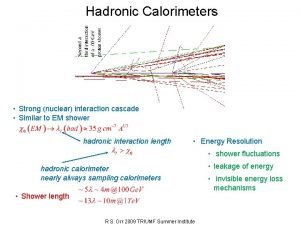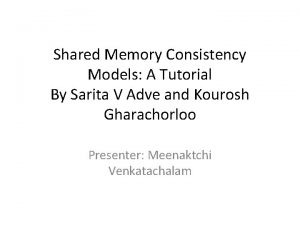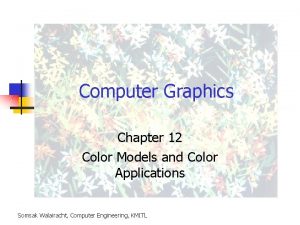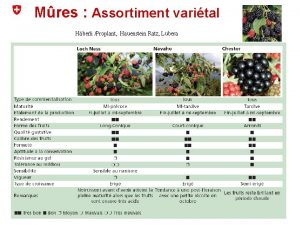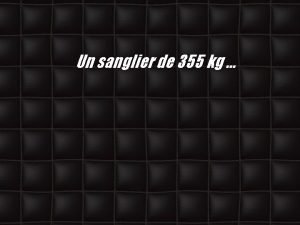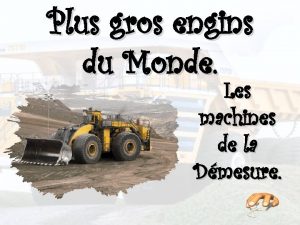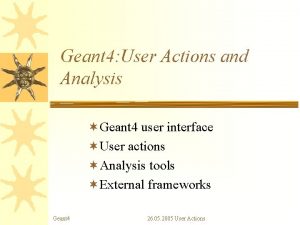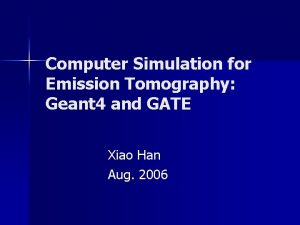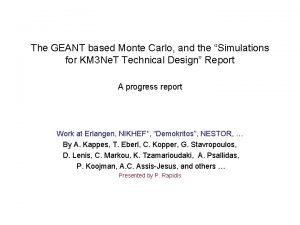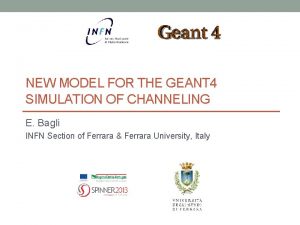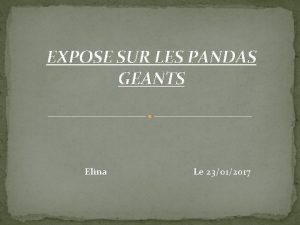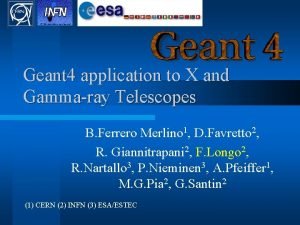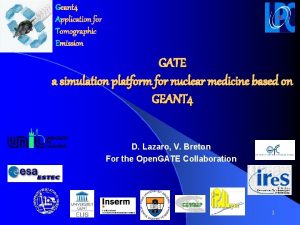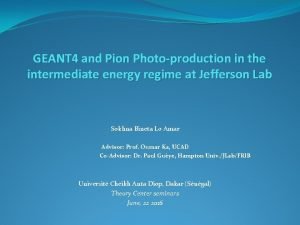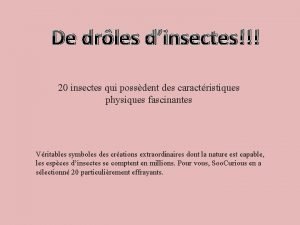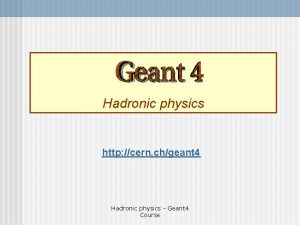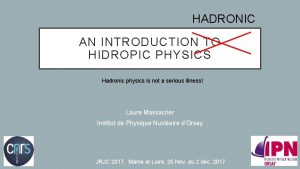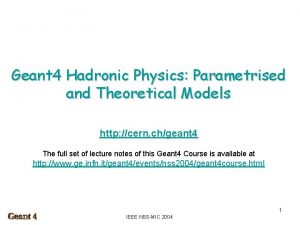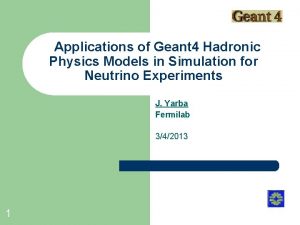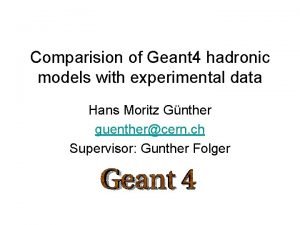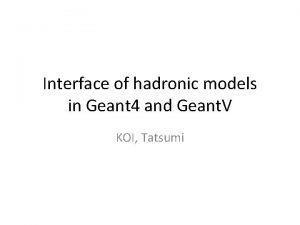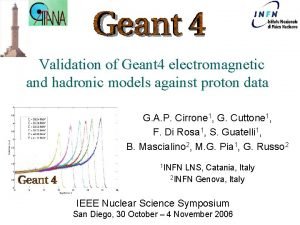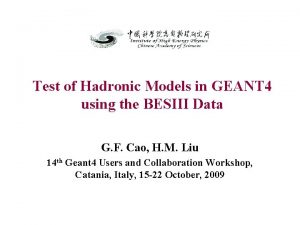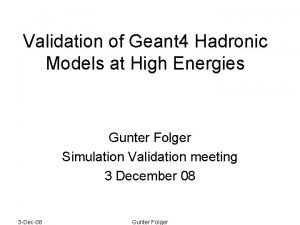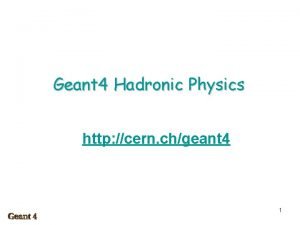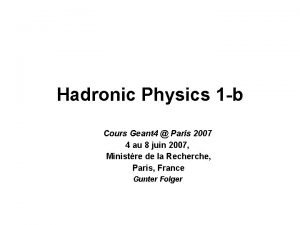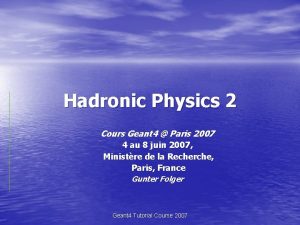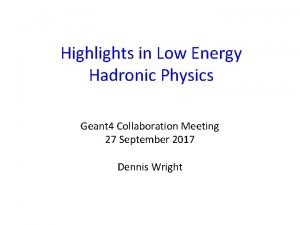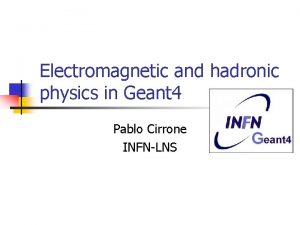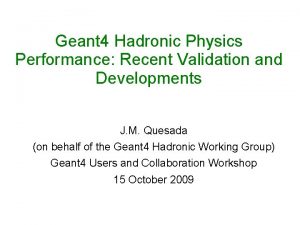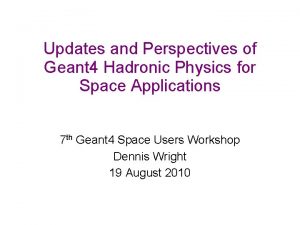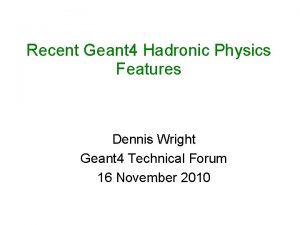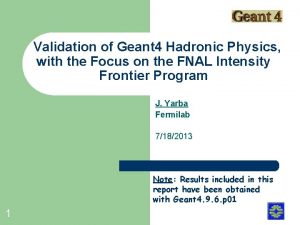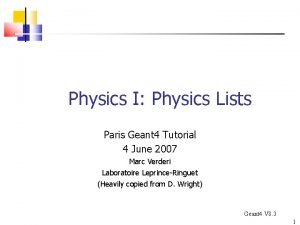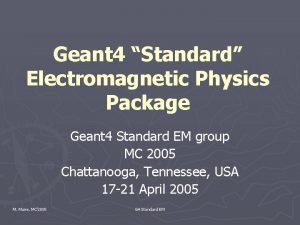Geant 4 Hadronic Physics Models Geant 4 Tutorial

























- Slides: 25

Geant 4 Hadronic |Physics Models Geant 4 Tutorial CERN, 25 -27 May 2005 Gunter Folger

Overview n Parton String Models – QGS Model n Binary Cascade n Precompound Model n Nuclear de-excitation models n CHIPS n Capture

Parton String Models n Quark Gluon String model n Diffractive String Model n Models split into n Strings excitation part n String hadronization n Damaged nucleus passed to either n pre-compound model (QGSP physics list) n CHIPS for nuclear fragmentation (QGSC physics list)

Quark Gluon String Model n Pomeron exchange model n Hadrons exchange one or several Pomerons n Equivalent to color coupling of valence quarks n Partons connected by quark gluon strings

Quark gluon string model Algorithm A 3 -dimensional nuclear model is built up Nucleus collapsed into 2 dimensions The impact parameter is calculated Hadron-nucleon collision probabilities calculation based on quasi-eikonal model, using Gaussian density distributions for hadrons and nucleons. n Sampling of the number of Pomerons exchanged in each collision n Unitarity cut, string formation and decay. n n

QGSM - Results pi- Mg pi+ X , Plab 320 Ge. V/c Rapidity Pt 2 [Ge. V 2]

Binary Cascade n Modeling interactions of protons, neutrons, pions with nuclei n Incident particle kinetic energy 50 Me. V – 2 Ge. V n Extension for light ion reactions n Wounded nucleus passed to pre-compound model and nuclear de-excitation models.

Binary Cascade n Hybrid between classical cascade and full QMD model n Detailed model of Nucleus nucleons placed in space according to nuclear density n Nucleon momentum according to Fermi gas model n n Collective effect of nucleus on participant nucleons described by optical potential n Numerically integrate equation of motion

Binary Cascade n Interactions between primary (or secondary) with nucleon described as two body reactions n E. g. pp -> Δ(1232) N*(2190) n n Nucleon and delta resonances up to 2 Ge. V included Resonances decay according to lifetime

Binary Cascade - results p Pb -> n X

Pre-compound model n The pre-compound nucleus is viewed as consisting of two parts A system of excitons carrying the excitation energy and momentum n A nucleus, undisturbed apart from the excitons n n The exciton system is defined by the numbers of excitons, holes, and charged exitons and their total energy and momentum

Pre-compound Model n The system of excitons and the nucleus evolves through n n n Collisions between excitons (Δn=0, -2) Collisions between excitons and nucleons (Δn=+2) Particle and fragment emission (up to helium) n Until number of excitons is in equilibrium

Nuclear de-excitation models n Nucleus is in equilibrium n System is characterised by number of nucleons (A, Z) and excitation energy n Excitation energy is distributed over large number of nucleons n De-excite nucleus through evaporation

Nuclear de-excitation models n Weisskopf Ewing evaporation n GEM evaporation n Photon evaporation n Internal conversion n Fission n Heavy nuclei (A≥ 65) n Fermi break-up n Light nuclei ( A<17) n Multifragmentation n Large excitation energy U/A > 3 Me. V

Chiral Invariant Phase Space (CHIPS) n CHIPS is based on homogeneous invariant phase distribution of mass-less partons n Quasmon is ensemble of partons n Quasmon is characterised by mass MQ n Critical temperature TC defines number n of partons in Quasmon TC is only parameter of model n MQ ≈ 2 n TC n n Nucleus made of nucleon clusters

Chiral Invariant Phase Space (CHIPS) n Critical temperature defines hadronic masses (EPJA- 14, 265) n Simulation of proton-antiproton annihilation at rest (EPJA -8, 217) n n Quasmon creation in vacuum quark fusion hadronization mechanism for energy dissipation n Pion capture and evaporation algorithm (EPJA-9, 411) n Quasmon creation in nuclear matter n Quasmon can exchange quarks with nuclear clusters n quark exchange hadronization mechanism n Photonuclear reactions (EPJA-9, 421) n Photonuclear absorption cross sections (EPJA-14, 377)

Chiral Invariant Phase Space (CHIPS) n Momentum of primary parton is k=(E-B*m+p)/2 B is a baryon number of the secondary hadron, n E, p are energy and momentum of the secondary hadron n m is mass of nuclear cluster n measuring E and p of the hadron with known B, one can reconstruct spectra of primary partons. n In simplified one dimentional case (q momentum of recoil parton): n n Baryons: k+M=E+q, k=p-q -> k=(E-M+p)/2 (quark exchange) Mesons: k+q=E, k-q=p -> k=(E+p)/2 (quark-antiquark fusion) Antibaryons: k+q=M+E, k-q=p: k=(E+M+p)/2 (antiquark-antidiquark fusion) n In CHIPS the hadronization is made in three dimensions


Nuclear Capture of Negative Particles at Rest n This simulation does not need any interaction cross- section n Parameterised+theoretical models for π- and Kn n Absorption parameterised De-excitatin of nucleus nuclear de-excitation models n Core code: CHIPS (Chiral Invariant Phase Space) model n Valid for μ-, tau-, π-, K-, anti-proton, neutron, anti-neutron, sigma-, anti-sigma+, Xi-, Omega- n For μ- and tau- mesons this is a hybrid model creating n Photons and Auger electrons from intra-atomic cascade (electromagnetic process) n neutrinos radiated when the meson interacts with the nuclear quark (weak process) n hadrons and nuclear fragments, created from the recoil quark interacting with nuclear matter (hadronic process)

Nuclear Capture of Negative Particles at Rest using CHIPS (continued) n π- and K- mesons are captured by nuclear clusters with subsequent hadronization n Anti-barions (anti-hyperons) annihilate on the surface of nuclei with quasifree nucleons n secondary mesons interact with nuclear matter n neutrons are included for heavy nuclei, which can absorb low energy neutrons and decay.

Using Nuclear Capture of Negative Particles at Rest using CHIPS n The G 4 QCapture. At. Rest process can be used for all negative particles, for negative pions: G 4 Pion. Minus. Inelastic. Process the. Pion. Minus. Inelastic; G 4 LEPion. Minus. Inelastic* the. LEPion. Minus. Model; G 4 Multiple. Scattering the. Pion. Minus. Mult; G 4 h. Ionisation the. Pion. Minus. Ionisation; G 4 QCapture. At. Rest the. Pion. Minus. Absorption; p. Manager = G 4 Pion. Minus: : Pion. Minus()->Get. Process. Manager(); p. Manager->Add. Discrete. Process(&the. Elastic. Process); the. LEPion. Minus. Model = new G 4 LEPion. Minus. Inelastic(); the. Pion. Minus. Inelastic. Register. Me(the. LEPion. Minus. Model); p. Manager->Add. Discrete. Process(&the. Pion. Minus. Inelastic); p. Manager->Add. Process(&the. Pion. Minus. Ionisation, ord. In. Active, 2, 2); p. Manager->Add. Process(&the. Pion. Minus. Mult); p. Manager->Add. Rest. Process(&the. Pion. Minus. Absorption, ord. Default);

Validation of CHIPS model for pion Capture at Rest on Carbon n {use attached picap. C. eps file}

Validation of CHIPS for Anti-Proton Capture at Rest on Uranium n {use attached u 92146_c. eps file}

Also…. . n Inelastic Ion reactions n Binary Cascade n Abrasion/Ablation n Electromagnetic dissociation n Nuclear elastic n Coherent elastic nucleon-nucleon scattering n Muon nuclear n Leading Particle Bias (partial MARS re-write) n Radioactive decay n Biasing

Summary n Validation of physics list for specific use case important n For new use cases absolutely needed n Further reading: n Geant 4 Physics reference manual n Navigate from Geant 4 home page http: //cern. ch/geant 4 n Geant 4 «Results&Publications» web page n “Physics of shower simulation at LHC, at the example of Geant 4”, J. P. Wellisch, CERN Academic training March 1 -4, 2004. n http: //agenda. cern. ch/full. Agenda. php? ida=a 036555
 Hadronic
Hadronic Hadronic shower
Hadronic shower Semi modals examples
Semi modals examples Shared memory consistency models a tutorial
Shared memory consistency models a tutorial Different color models in computer graphics
Different color models in computer graphics Myrtillier géant
Myrtillier géant Geant network map
Geant network map Sanglier attila
Sanglier attila Plus grosse excavatrice au monde
Plus grosse excavatrice au monde Action geant
Action geant Geant computer
Geant computer Geant simulation
Geant simulation Geant 4
Geant 4 Gant atlas
Gant atlas Exposé panda
Exposé panda Geant 4
Geant 4 Geant 4
Geant 4 Pub geant
Pub geant Gate geant
Gate geant Pion geant
Pion geant Scutigere geant
Scutigere geant Why does it happen
Why does it happen University physics with modern physics fifteenth edition
University physics with modern physics fifteenth edition Physics ia topic
Physics ia topic Why business models matter
Why business models matter Vsepr theory assignment
Vsepr theory assignment

